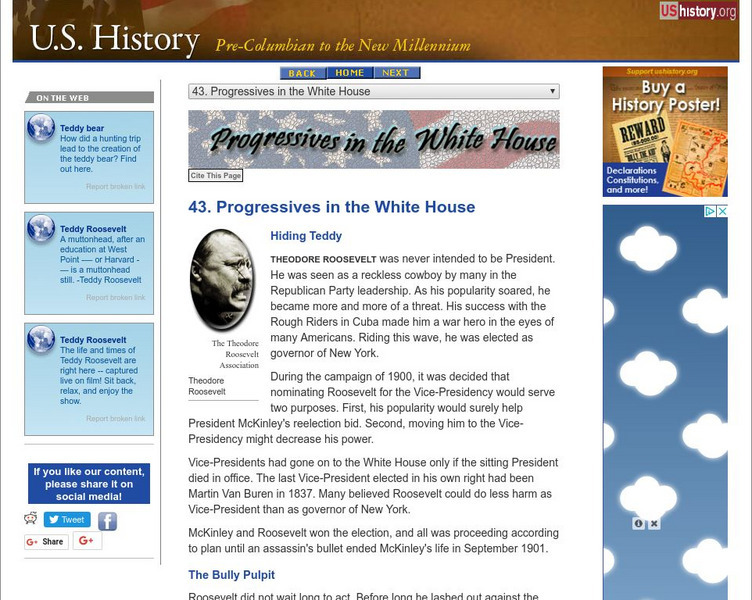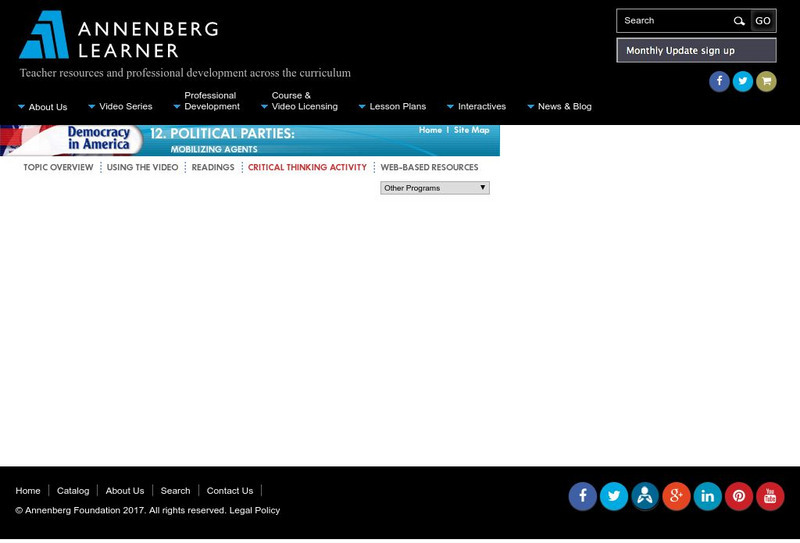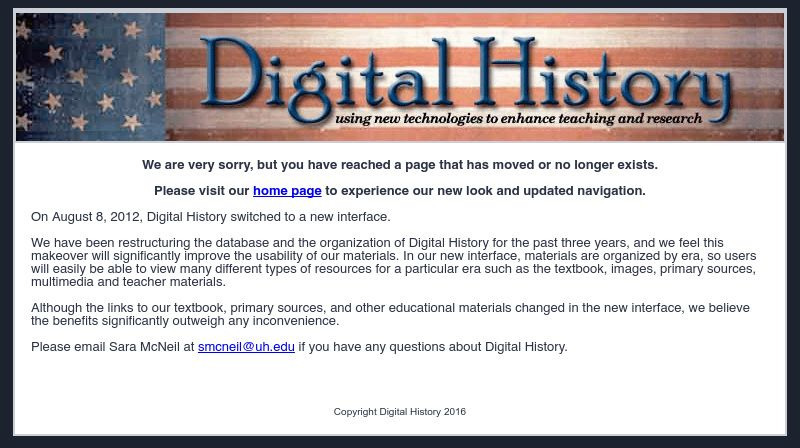CPALMS
Florida State University Cpalms: Florida Students: Party On: Political Parties in America
This tutorial examines the political parties in the United States. It looks at the two main parties, third parties, and independents. A PDF file of the tutorial is available.
University of Virginia
Miller Center at Uva: u.s. Presidents: John Adams: A Life in Brief
A good look at John Adams as president and the struggles he had both domestically and in foreign affairs. Read about how he kept America out of war and his political isolation because of his hard-held beliefs.
University of Virginia
Miller Center at Uva: u.s. Presidents: James Monroe: Campaigns and Elections
An interesting look at the elections of 1816 and 1820 in which James Monroe ran essentially unopposed by the Federalists.
University of Pennsylvania
Project Gutenberg.: Memoirs of Aaron Burr, With Correspondence
Project Gutenberg offers the complete text of Aaron Burr's correspondence online in plain text format.
Annenberg Foundation
Annenberg Learner: Democracy in America: Political Parties: Mobilizing Agents
This unit examines the significance of political parties in American politics, highlighting their functions, differences, and influence on the public for political decision making. Offers video, readings, web resources, and activities.
University of Virginia
Miller Center at Uva: u.s. Presidents: John Quincy Adams
This site contains a detailed biography of John Quincy Adams. From the right-hand toolbar, select information about his life before and after his presidency, his campaigns and elections, and his domestic and foreign affairs. Also, you...
Harp Week
Harp Week: Elections: 1892 Overview Cleveland v. Harrison v. Weaver
This four-page review of the campaign and election of 1892 includes a review of Benjamin Harrison's term in office from 1888-1892, the controversy in determining a presidential candidate, and the presence of a possibly viable third-party...
Khan Academy
Khan Academy: Ap Us History: Period 6: 1865 1898: Politics in the Gilded Age
The study resource from Khan Academy provides an overview of Period 6: 1865-1898 in American History. The politics in the Gilded Age is discussed in this lesson. This resource is designed as a review for the AP US History Test.
PBS
Pbs: American Experience: Presidential Politics: Lyndon B. Johnson
Here, read about the 1964 election, through which Republicans planned to "unseat President Lyndon Johnson." Learn about the man nominated by the Republicans, Barry Goldwater, about Johnson's own feelings of inadequacy, and about the 1964...
Other
Us News and World Report: Teddy Roosevelt, on the Bull Moose Party Ticket
A great explanation of the divide in the Republican Party in the campaign of 1912, which resulted in Theodore Roosevelt becoming a third-party candidate. Read about the vying between two Progressives, one Democratic and one previously...
National Humanities Center
National Humanities Center: Toolbox Library: Wall Street Speech, the Gilded and the Gritty: America, 1870 1912
A "bloody shirt" speech from Robert Ingersoll that emphasizes the virtue of Republican candidates and attacks Democrats as traitors during the Civil War.
Country Studies US
Country Studies: Taft and Wilson
A good overview of the domestic policies of William Howard Taft, the Republican president elected in 1908, and the reforms of Woodrow Wilson, Democratic candidate, who was elected in 1912.
Digital History
Digital History: War on the Judiciary
The Judiciary Act of 1801 was a final attempt by the Federalists to control the judicial system before the Democratic Republicans took over. Read about the repeal of the act, which resulted in a landmark Supreme Court decision, Marybury...
University of Virginia
Ua: The New Deal for African Americans
Short essay discussing how the programs of the New Deal changed the African American political support from Republican to Democrat. Includes photo.
Other
Education Extras: Presidential Election of 1896 [Pdf]
In this lesson students first explore the party platforms of the Republican, Democratic, Populist, and Greenback Parties. They then read informational texts and complete a graphic organizer about the readings. After students share their...
CNN
Cnn: 10 Ways a Government Shutdown Will Affect Your Daily Life
With the deadlock between Republicans and Democrats over Obamacare, the government had to shut down in 2013. This article explains the ramifications of this for the average American. (Published: October 1, 2013)
Ohio State University
Temperance & Prohibition: Prohibition Party Cartoons
A great collection of political cartoons from the Prohibition Party which heaped criticism on both the Republican and Democratic parties concerning their lack of support for prohibition. Find out when the Prohibition Party was at its...
Independence Hall Association
U.s. History: Progressives in the White House
Read a brief overview of the three presidents, two Republican and one Democrat, who believed in an activist government to help all the people, and pushed for legislation to reflect their views.
University of Virginia
Miller Center at Uva: u.s. Presidents: William Howard Taft: Campaign and Election of 1908
Read about the presidential candidates from the Republican, Democratic, and Socialist parties in the election of 1908. See the party platforms and the reasons Taft won the election.
Ohio State University
Ohio State University: Think Political News Is Biased? Depends Who You Ask
Article about Ohio State University study that explores whether Republicans or Democrats think political news is biased. (Published April 7, 2003)
Annenberg Foundation
Annenberg Learner: What Is Your Affiliation?
Political parties have platforms that describe their principles and issue stances in areas such as taxes, education and immigration. Answer the questions to see which party (Democratic, Republican, Green and Libertarian) is your best fit.
Other
President Elect: 1908
An overview of the candidates for president in the election of 1908 in which the primary candidates were William H. Taft, William Jennings Bryan, and Eugene V. Debs. The electoral map shows how split the country was between Republicans...
American Rhetoric
American Rhetoric: Margaret Chase Smith: "Declaration of Conscience"
This is the text of Senator Margaret Chase Smith's "Declaration of Conscience," a list of how Republicans and Democrats should act, delivered on June 1, 1950.
Digital History
Digital History: Shifting Political Values
A description of the changing ideas of the young Democratic Republicans and the three men who, in the 1820s, supported those values. These three men would be important players in the national government for the next 40 years.


















